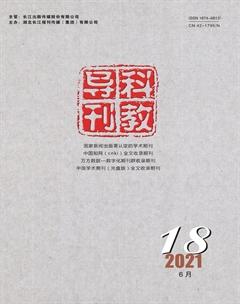“走教案”偏离了育人目标
2021-01-09李德强
李德强
課堂上的“走教案”指的是,教师按照课前设计好的教学流程亦步亦趋地上完整节课,当遇到超出设计范围的教学事件时,依然我行我素,直至完成所有的教学预设环节。
“走教案”被批评的原因中比较一致且较为关键的一点,就是没有充分关注到学生,没有根据学情作出即时调整,没有在课堂上以生为本、以学定教。然而,这样的评判更多关注了课堂上的教学行为,却没有分析导致这些行为的背后原因。要从根本上使“走教案”演变成更能体现科学教育价值追求的教学过程,关键是弄清应该落实什么样的教学设计,落实教学设计需要什么样的科学教师。
许多教师的教学设计,大致包括教材分析、学情分析、教学目标、教学重难点、教学准备、教学过程以及板书等内容。有些教学设计的教学过程写得很详细,似乎课堂上的每一情景都能被预估出来,比如在某一环节学生可能讲什么,教师应该如何回应等。但教学一旦展开,面对活生生的教学对象,课的走向也就不会尽如人意了,可是为什么“走教案”还能走下去呢?仔细观察“走教案”的教学设计就会发现,既定的认知目标占据着教师的思维空间,教案更多的是在认知层面进行思考与设计。
事实上,以认知为目标的教学更能通过一步步的“问答”或者“环环相扣”呈现出来。上课时,无论教师的教还是学生的学,都以靠近并达到教案的预定安排为理想。于是,上课变成了执行教案的机械过程,碰到了“预设”的情形便直接搬出设计好的方案,出现了意料之外的情形,就“牵着学生的鼻子”走向预想的目标。表面看起来,教学目标达成了,学生却变成了名副其实的配角,甚至是旁观者。
很显然,导致这样“走教案”现象的关键在于对教学目标的局限性认识与落实上,科学教育除了认知目标以外,科学探究、科学态度、社会责任等素养都是重要的教学追求,教学中需要将学生置于真实的自然、社会环境中,促成真实而深度的合作建构学习,达成“人的成长”目标。改变认知目标以外的其他目标的从属地位,使得它们构成一个完整、完美的教学目标,并不是一件简单的事情,这需要教师深刻领悟科学课程的育人目标,并把它在课堂上转化为教学行为。
有学者总结出了科学教师应该具备的基本能力,如课程的整合能力、教学组织能力、实验能力、表达交流能力等。我们可以这样认为,这些能力都是科学教师落实教学设计的必要的专业能力。但这些能力是怎样形成的呢?绝大多数情况下,科学教师的教学专业能力都是在接受基础的师范教育之后,依赖于后续的科学课堂情境发展起来的。这实际上道出了一个事实——科学教师的能力也是一个不断“建构”的过程,在这个过程中,有的科学教师只关注规范能力,比如说怎样去指导孩子们按照要求做完一个实验,如何把孩子们在课堂上控制得井然有序等;有的科学教师会不断发现在实践中所出现的、超出已有能力范围的新事件,认识到这样实践的存在并创造性地做出及时反应,使后面的事件发展更符合教学的需要。一般来讲,前者能够完成规定好的教学流程,是在“走教案”,后者才能适应富有生命活力的科学课堂。观察众多优秀的科学教师,我们就会发现,他们都是在这样不断的“反应”中,让自己的课堂教学变得越来越睿智、淡定和艺术。
“Teaching plan”Deviates from the Goal of Education
LI Deqiang
中图分类号:G424文献标识码:ADOI:10.16400/j.cnki.kjdk.2021.18.003
LI Deqiang
Deputy Editor in Chief of Science Textbook of People’s Education Hubei Education Press
Vice Chairman of Primary School Science Teaching Steering Committee of Hubei Provincial Department of Education
Excellent Expert in Yichang City, Hubei Province
The "teaching plan" in the classroom refers to that teachers follow the teaching process designed be? fore class to complete the class step by step. When theyencounterteachingeventsbeyondthedesign scope, they still go their own way until all the teach? ing preset links are completed.
One of the more consistent and crucial reasons for the criticism of "teaching plan" is that it did not pay enough attention to students, did not make imme? diate adjustment according to the learning situation, anddidnottakestudentsasthefoundationand teach according to learning in class. However, this kind of judgment pays more attention to the class? room teaching behavior, but does not analyze the rea? sons behind these behaviors. In order to make the"teaching plan" evolve into a teaching process that can better reflect the value pursuit of science educa? tion, the key is to make clear what kind of teaching design should be implemented and what kind of sci? ence teachers are needed to implement the teaching design.
The teaching design of many teachers includes teaching material analysis, learning situation analysis, teachingobjectives,teachingdifficulties,teaching preparation, teaching process and blackboard writing. The teaching process of some instructional design is very detailed. It seems that every scene in the class? room can be predicted, such as what students may say in a certain link and how teachers should re? spond. But once the teaching is launched, in the face of the living teaching object, the trend of the class will not be satisfactory, but why can "teaching plan" go on? Careful observation of the teaching de? sign of "teaching plan" will find that the established cognitive goals occupy the teachers’ thinking space, and the teaching plan is more in the cognitive level of thinking and design.
In fact, the teaching of cognition can be present? ed step by step through "question and answer" or"interlocking". In class, whether teachers teach or stu? dents learn, it is ideal to be close to and achieve the predetermined arrangement of the teaching plan.As a result, class has become a mechanical process of carrying out the teaching plan. When it comes to the "preset" situation, it directly moves out of the de? signed plan. When it comes to unexpected situations, it "leads the students by the nose" to the expected goal. On the surface, it seems that the teaching goal has been achieved, but the students have become re? al supporting roles, even bystanders.
Obviously, the key to this phenomenon lies in the understanding and implementation of the limita? tions of teaching objectives. In addition to cognitive objectives, scientific inquiry, scientific attitude, social responsibility and other qualities are important teach? ing pursuits in science education. In teaching, stu? dents need to be placed in a real natural and social environmenttopromoterealanddeepcooperative constructivelearning,achievethegoalof"human growth". It is not a simple thing to change the subor? dinate status of other goals besides cognitive goals and make them form a complete and perfect teaching goal, whichrequiresteacherstodeeplyunderstand the educational goal of science curriculum and turn it into teaching behavior in the classroom.
Some scholars have summed up the basic abili? ties that science teachers should have, such as curric? ulum integration ability, teaching organization ability, experimentalability,expressionandcommunication ability, etc. We can think that these abilities are nec? essary professional abilities for science teachers to im? plement instructional design. But how do these capa? bilities come into being? In most cases, the teaching professional ability of science teachers is developed after receiving basic normal education and relying on thefollow-upscienceclassroomsituation.Infact, this shows a fact that the ability of science teachers isalsoaprocessofcontinuous"construction".In this process, some science teachers only focus on nor? mative ability, such as how to guide children to com? plete an experiment according to requirements, how tocontrol childreninorder inclass, andsoon; Somescienceteacherswillconstantlyfindnew events in practice that are beyond the scope of their existing ability, recognize the existence of such prac? tice and creatively respond in time, so as to make the development of the following events more in line with the needs of teaching. Generally speaking, the former is able to complete the prescribed teaching process,isinthe"teachingplan",thelattercan adapt to the vitality of the science classroom. If we observe many excellent science teachers, we will find that they make their classroomteaching more and more intelligent, calm and artistic in such constant"reaction".
